Last updated: October 15, 2018
Article
Pershing Park
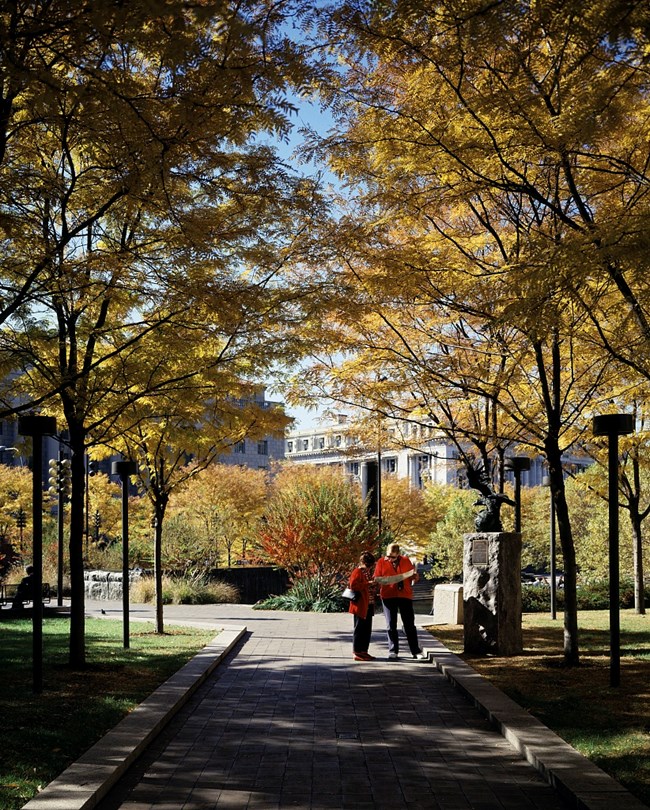
Library of Congress, Prints & Photographs Division, photograph by Carol M. Highsmith [LC-DIG-highsm-12541]
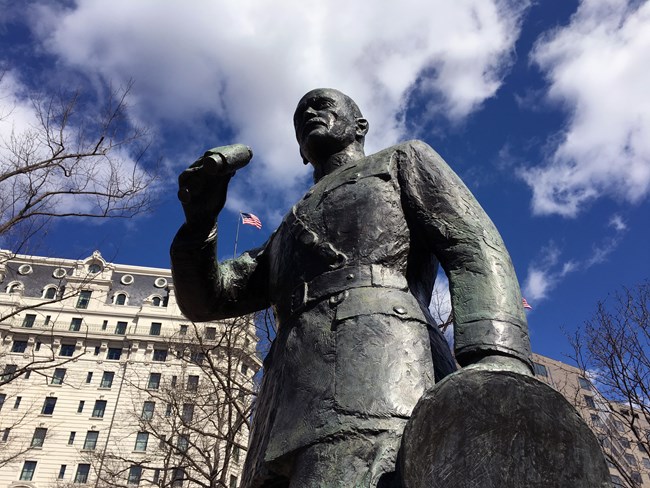
NPS
Pershing Park covers a 1.76-acre trapezoid-shaped landscape, designed by M. Paul Friedberg, with later revisions by Oehme-Van Sweden, and bordered by Pennsylvania Avenue and 14th, 15th and E Streets, NW. The park and the adjacent Freedom Plaza to the east represent the culmination of a twenty-year effort to provide an impressive terminus for Pennsylvania Avenue as it approaches the historic White House grounds and opens toward the Washington Monument and the National Mall to the south. Dedication events marked the opening of Pershing Park on May 14, 1981.
National Mall and Memorial Parks (NAMA) assumed its responsibility in 1965 to preserve and administer the monumental core of the nation’s capital, home to many of this nation’s iconic structures, landscapes and vistas. NAMA oversees Pennsylvania Avenue National Historic Site, also designated in 1965 to preserve areas associated “with events and people of large consequence in the history of the Republic and its Capital.” General Pershing certainly fits that description. In 1972, Congress created the Pennsylvania Avenue Development Corporation to oversee a series of improvements to enhance the appearance of this important historic district—America’s Main Street. Pershing Park soon became one of the focal elements for a renewed Pennsylvania Avenue. Designers sought to realize the great potential that the site provided, not only for its relevance to General John J. Pershing but also for its association with important historical events in the city and the nation.
The effort to erect a Pershing memorial in Washington, D.C. emerged shortly after the general’s 1948 death at Walter Reed Army Medical Center and subsequent burial with full military honors at Arlington National Cemetery. Presidents Harry S Truman and Dwight D. Eisenhower, both military service veterans of World War I, supported the memorial campaign.
On April 2, 1956—the 39th anniversary of President Woodrow Wilson’s address to a Joint Session of Congress requesting a declaration of war against Germany—Congress authorized the erection of a memorial in Washington, D.C. to General Pershing. The impetus to build the memorial also came with the approach of the 1960 Centennial of the general’s birth and the discovery in that year of the disappearance of his equestrian statue at Versailles, France. Dedicated in Pershing’s presence in 1937, the equestrian statue honoring him and the troops of the American Expeditionary Force (A.E.F) vanished following the fall of France during World War II; Nazi leaders apparently ordered the Pershing Memorial be dismantled and melted down to make artillery shells.
As national Veterans Day observances loomed in 1966, Congress passed, on November 7, another public law authorizing the construction of a memorial along Pennsylvania Avenue to honor both Pershing and the A.E.F. troops he commanded. The area selected, previously designated as Reservation No. 617, City Square 226, Commerce Building Plaza and Pershing Square, became Pershing Park. Realization of an actual memorial took another fifteen years.
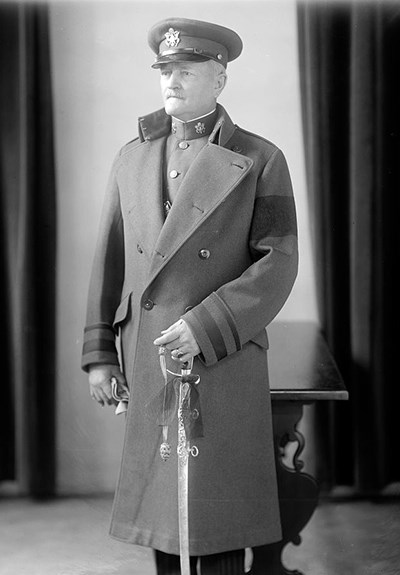
Library of Congress, Prints & Photographs Division, photograph by Harris & Ewing, [LC-DIG-hec-18592]
General Pershing unveiled the American Battle Monuments Commission (ABMC) in1923 to survey the battlefields of the Western Front and oversee both the creation of memorials and military cemeteries to commemorate the service and sacrifice of the American Expeditionary Forces. Pershing dispatched to Europe a young army officer, Major Dwight D. Eisenhower, on a late 1920s inspection tour of American battlefields of World War I in order to edit and correct the ABMC’s official guidebook. ABMC continues to execute its important mission and remains associated with military memorial sites both overseas and here at home, including the nearby World War II Memorial. At the dawn of the 1980s, ABMC ensured the legacy of General John J. Pershing and the American veterans of World War I when it marched directly to the support of its mission and its founder by funding the American Expeditionary Forces Memorial and the General Pershing portrait statue.
John J. Pershing devoted his life to serving his country and remains most deserving of his memorial along America’s Main Street. Pershing saw service along America’s western frontier, during the Spanish-American War and in Mexico before he commanded the American Expeditionary Force sent to Europe in 1917. During his service in Mexico in 1915, he received word that a fire at the Presidio in San Francisco, California took the lives of his wife and three daughters, sparing only the life of his son, Warren. Pershing somehow recovered from this tragedy with enough strength to lead American forces toward Allied victory in World War I. He resisted calls to distribute his troops among the Allies, preferring to keep intact the fighting integrity of American units. His refusal allowed for an appreciation of American contributions toward eventual victory.
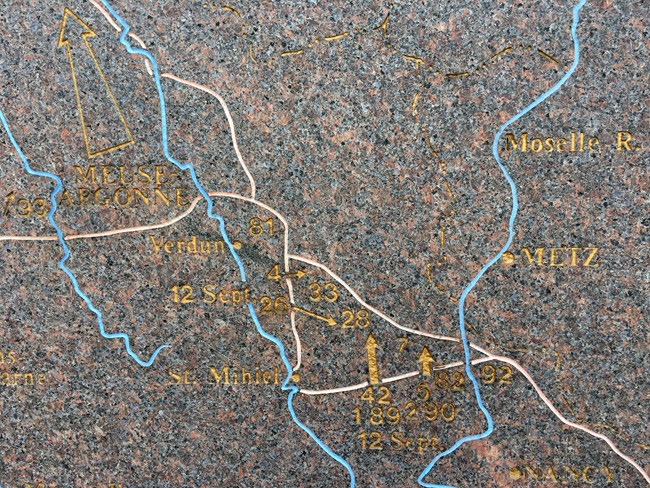
NPS
The American Expeditionary Forces Memorial, designed by architect Wallace Harrison, represents to some degree the scene that greeted American forces arriving in 1917 and 1918. Set amongst trees, an open 52-foot by 75-foot granite plaza, bordered by two ten-foot high Dakota mahogany granite walls, provides a sense of how the war transformed once verdant fields and forests into the stark, lifeless landscape of trenches, shell holes and battlefields. Standing within the memorial plaza, one feels the isolation of life in the trenches. Hopeful feelings abide here as well, for on the south wall one finds maps of the American sectors of the Western Front and inspiring text panels describing the vital contributions of American forces toward winning and ending the Great War, not only on the Western Front but throughout other sectors as well.
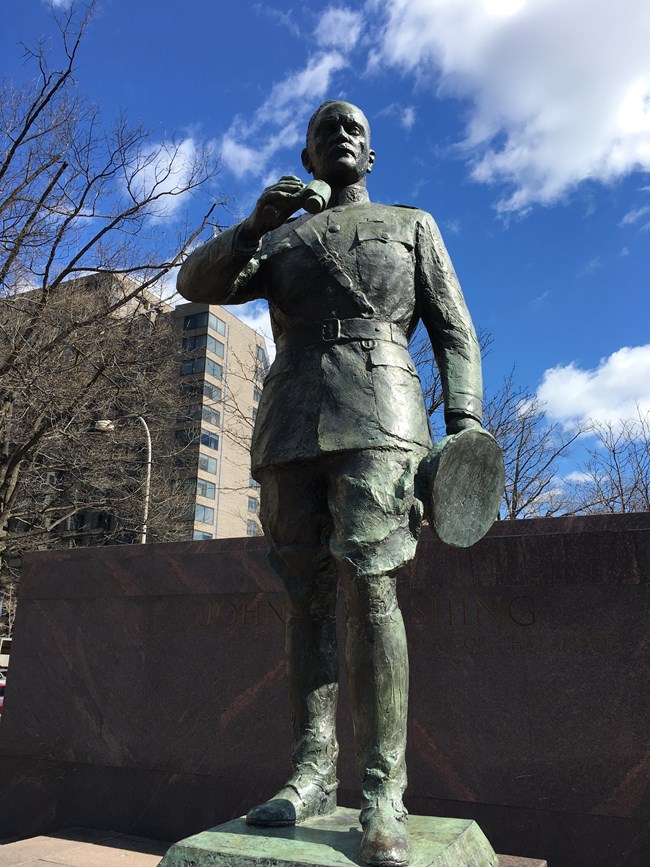
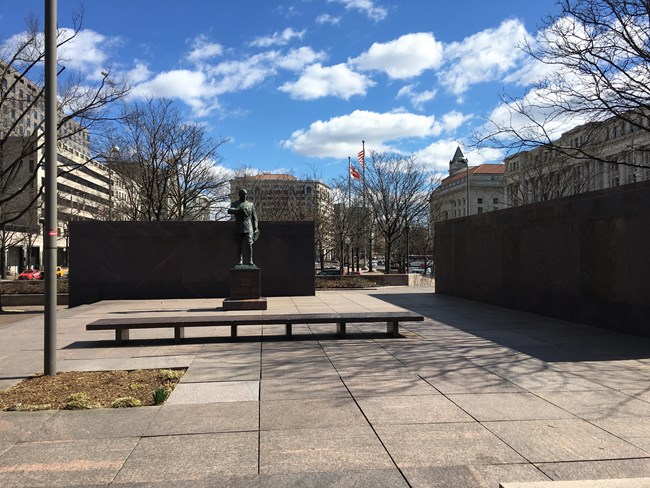
As with most areas preserved by National Mall and Memorial Parks, Pershing Park offers its share of great views, iconic vistas and historical connections. General Pershing’s statue stands oriented westward toward his native Missouri, where in November 1921 he helped lay the cornerstone for Kansas City’s Liberty Memorial honoring the American and Allied victors of World War I. The statue also looks upon the western portion of Pershing Park where Congress has directed the construction of a National World War I Memorial. Directly across 15th Street is the memorial honoring General William T. Sherman, a man whom Pershing deeply admired and from whom Pershing received his diploma upon his 1886 graduation by the United States Military Academy.
South of Pershing Park is the Federal Triangle office complex that contains two significant ties to the American Expeditionary Forces. Inside the John A. Wilson District Building is a marble sculpture depicting a fallen American soldier beneath which is a list of District Government employees who lost their lives in the Great War. Beyond, within the Ronald Reagan Building, is a memorial to Pershing’s wartime commander-in-chief, Woodrow Wilson. To the north, stands the historic Willard Hotel where in 1922 Pershing met with several hundred officers (many of which were World War I combat veterans) to form the Reserve Officers Association.
From the 14th Street side of Pershing Park, the grand vista of Pennsylvania Avenue stretches for more than a mile to the foot of Capitol Hill. It was along this route in September 1919 that General Pershing led the World War I Victory Parade from Capitol Hill toward the White House. Pershing also took part in the funeral processions along this same route for the Unknown Soldier of World War I in 1921 and for President Warren G. Harding who had died in office in 1923.
Second only to Washington, Pershing outranks all the great five-star army generals of World War II—Marshall, MacArthur, Eisenhower, Arnold and Bradley. Interesting as well is the fact that Pershing Park stands in perfect alignment with the angle of Arlington Memorial Bridge, directly connecting this memorial park with Arlington National Cemetery two miles to the southwest and the final resting place of General Pershing.
